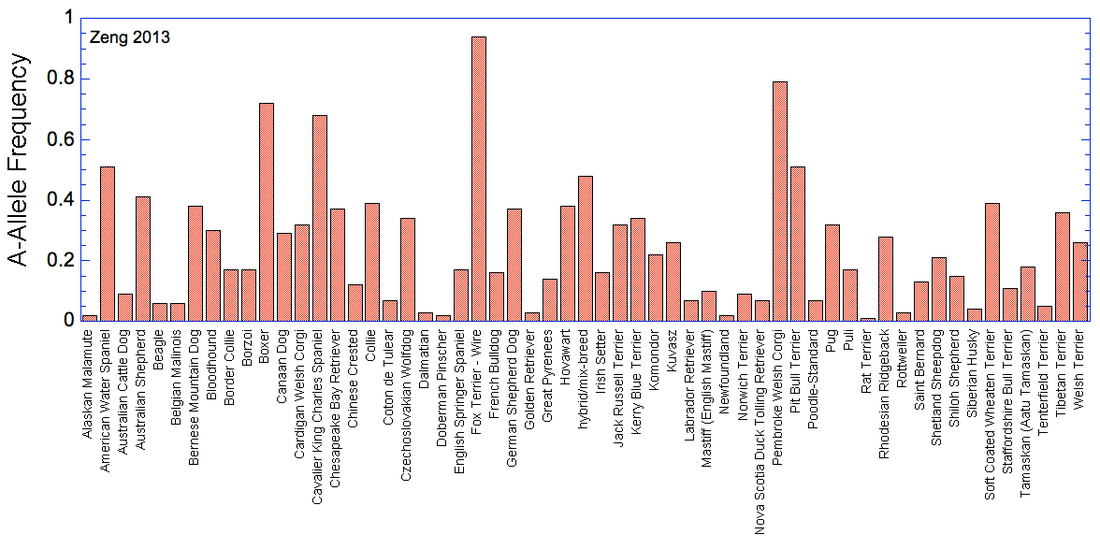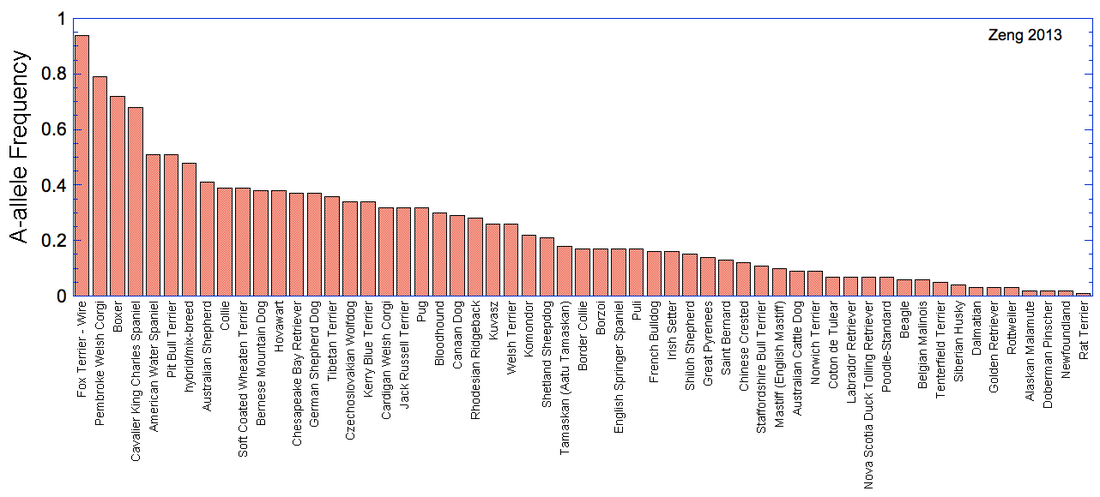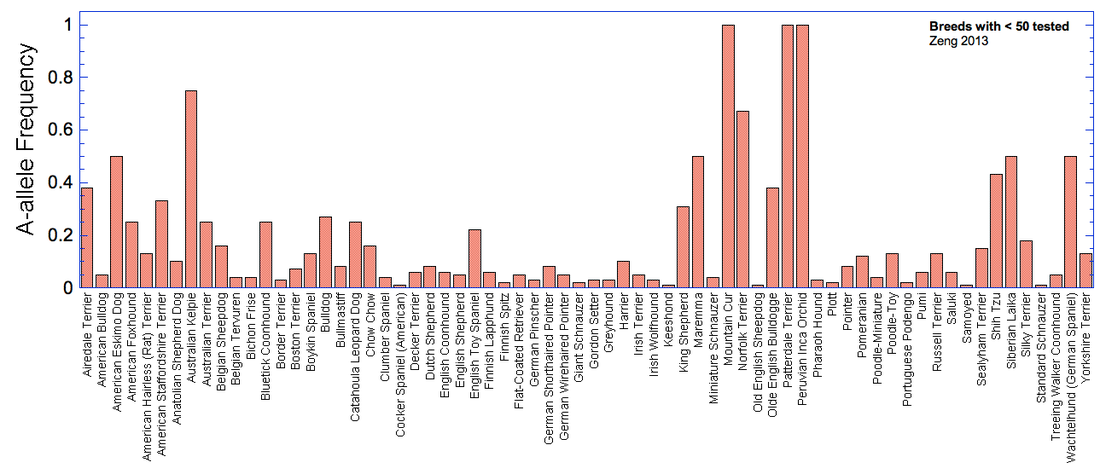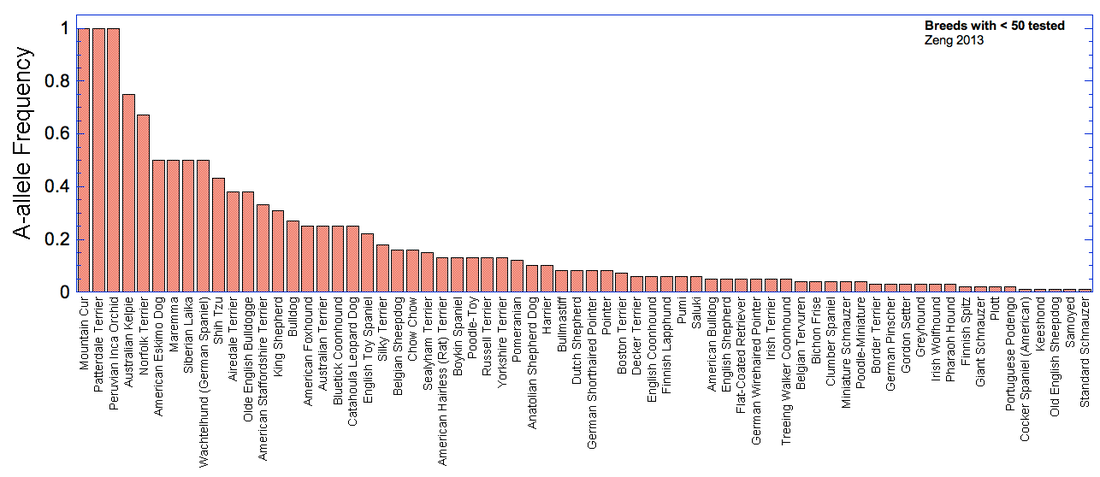Degenerative Myelopathy
by Carol Beuchat PhD
Data from -
This study reports a new mutation causing degenerative myelopathy (DM) that has so far been found only in Bernese Mountain dogs (SOD1:c.52T). The allele appears to be rare in this breed and was not found in any of the other breeds examined, including the closely related Greater Swiss Mountain dog.
A gene previously reported to be associated with DM in dogs (SOD1:c.118A) was found in 124 of 222 breeds examined as well as in mixed breed dogs. For about 35 of the breeds in which SOD1:c.118A was not found, the sample size was 10 or fewer, and of the remainder the largest sample was 112; these sample sizes are too small to rule out the occurrence of the mutation in these breeds (see Supplentary Table 2, download below). Among the breeds with the highest frequencies of the mutation (between about 25-100% carrier or homozygous) were (by rank) Wire Fox Terrier, Pembroke Welsh Corgi, Boxer, Cavalier King Charles Spaniel, American Water Spaniel, Pit Bull Terrier, Australian Shepherd, Collie, Soft-coated Wheaten Terrier, Bernese Mountain Dog, Hovawart, Chesapeake Bay Retriever, German Shepherd, Tibetan Terrier, Kerry Blue Terrier, Cardigan Welsh Corgi, Jack Russell, Pug, Bloodhound, Canaan Dog, Rhodesian Ridgeback, Kuvasz, Welsh Terrier (Figure 2 below). In the first five of these breeds, the allele was found in more than 50% of individuals examined.
Download:
- Zeng R, JR Coates, GC Johnson, L Hansen, T Awano, A Kolicheski, E Ivansson, M Perloski, K Lindblad-Toh, DP O'Brien, J Guo, ML Katz & GS Johnson 2014 Breed distribution of SOD1 alleles previously associated with canine degenerative myelopathy. J Vet Intern Med 28: 415-521.
This study reports a new mutation causing degenerative myelopathy (DM) that has so far been found only in Bernese Mountain dogs (SOD1:c.52T). The allele appears to be rare in this breed and was not found in any of the other breeds examined, including the closely related Greater Swiss Mountain dog.
A gene previously reported to be associated with DM in dogs (SOD1:c.118A) was found in 124 of 222 breeds examined as well as in mixed breed dogs. For about 35 of the breeds in which SOD1:c.118A was not found, the sample size was 10 or fewer, and of the remainder the largest sample was 112; these sample sizes are too small to rule out the occurrence of the mutation in these breeds (see Supplentary Table 2, download below). Among the breeds with the highest frequencies of the mutation (between about 25-100% carrier or homozygous) were (by rank) Wire Fox Terrier, Pembroke Welsh Corgi, Boxer, Cavalier King Charles Spaniel, American Water Spaniel, Pit Bull Terrier, Australian Shepherd, Collie, Soft-coated Wheaten Terrier, Bernese Mountain Dog, Hovawart, Chesapeake Bay Retriever, German Shepherd, Tibetan Terrier, Kerry Blue Terrier, Cardigan Welsh Corgi, Jack Russell, Pug, Bloodhound, Canaan Dog, Rhodesian Ridgeback, Kuvasz, Welsh Terrier (Figure 2 below). In the first five of these breeds, the allele was found in more than 50% of individuals examined.
Download:
- Supplementary Table 2 (breed incidence data)
| zeng_et_al_2014_breed_distribution_of_sod1_alleles_previously_associated_with_canine_degenerative_myelopathy.pdf | |
| File Size: | 97 kb |
| File Type: | |
Figure 1a & b- Breeds with > 50 individuals tested
If allele frequency = 0.5, half of all individuals have the allele; if frequency = 1, all animals have the allele.
Figure 2a & b- Breeds with < 50 tested
A-allele Frequency: note that for some of these breeds, there might have been only a single individual tested, and if it carried the allele the value for that breed would be 1 (i.e., 100%); these are breeds for which larger sample sizes are necessary to get better data for actual frequency.
A-allele Frequency: note that for some of these breeds, there might have been only a single individual tested, and if it carried the allele the value for that breed would be 1 (i.e., 100%); these are breeds for which larger sample sizes are necessary to get better data for actual frequency.





